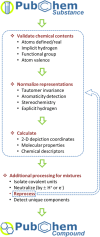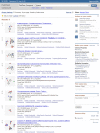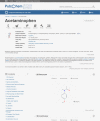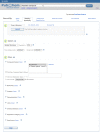PubChem Substance and Compound databases
- PMID: 26400175
- PMCID: PMC4702940
- DOI: 10.1093/nar/gkv951
PubChem Substance and Compound databases
Abstract
PubChem (https://pubchem.ncbi.nlm.nih.gov) is a public repository for information on chemical substances and their biological activities, launched in 2004 as a component of the Molecular Libraries Roadmap Initiatives of the US National Institutes of Health (NIH). For the past 11 years, PubChem has grown to a sizable system, serving as a chemical information resource for the scientific research community. PubChem consists of three inter-linked databases, Substance, Compound and BioAssay. The Substance database contains chemical information deposited by individual data contributors to PubChem, and the Compound database stores unique chemical structures extracted from the Substance database. Biological activity data of chemical substances tested in assay experiments are contained in the BioAssay database. This paper provides an overview of the PubChem Substance and Compound databases, including data sources and contents, data organization, data submission using PubChem Upload, chemical structure standardization, web-based interfaces for textual and non-textual searches, and programmatic access. It also gives a brief description of PubChem3D, a resource derived from theoretical three-dimensional structures of compounds in PubChem, as well as PubChemRDF, Resource Description Framework (RDF)-formatted PubChem data for data sharing, analysis and integration with information contained in other databases.
Published by Oxford University Press on behalf of Nucleic Acids Research 2015. This work is written by (a) US Government employee(s) and is in the public domain in the US.
Figures






References
-
- Bolton E.E., Wang Y., Thiessen P.A., Bryant S.H. PubChem: integrated platform of small molecules and biological activities. In: Wheeler RA, Spellmeyer DC, editors. Annual Reports in Computational Chemistry. Vol. 4. Amsterdam: Elsevier; 2008. pp. 217–241.
Publication types
MeSH terms
Substances
Grants and funding
LinkOut - more resources
Full Text Sources
Other Literature Sources
Miscellaneous

